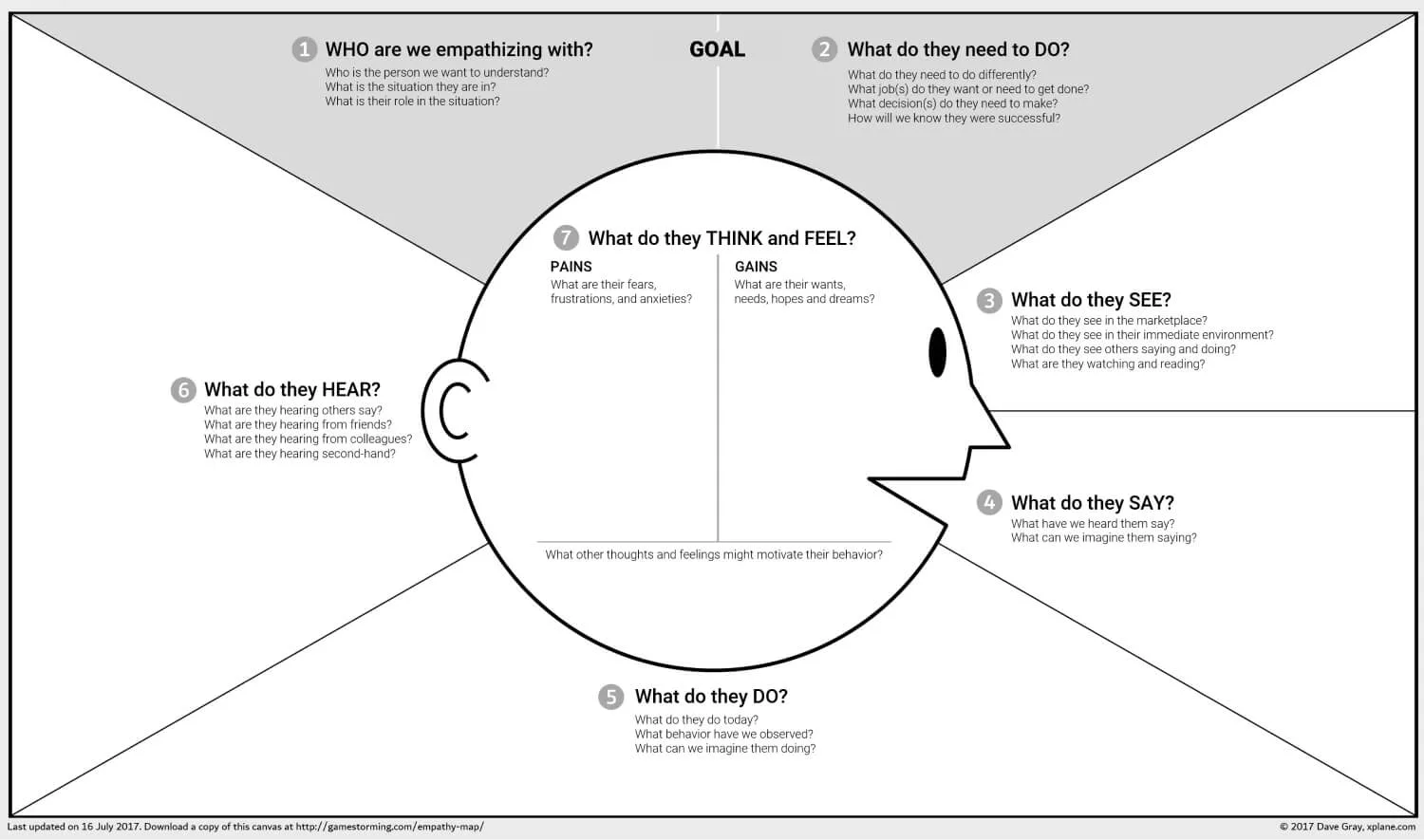Empathy map widely used by marketing and conversion optimization teams. After creating ideal customer profile (ICP), you can find more information about what is ICP and how you can create your own ICP), it’s important to create an empathy map. It helps you to understand your customer better, so you can optimize your marketing and optimize your store for better conversions.
In this article I’ll explain empathy map with details and explain how you can create your own one.

Empathy map asks seven important questions to understand your customers’ world.
- Who are we empathizing with?
- What do they need to do?
- What do they see?
- What do they say?
- What do they do?
- What do they hear?
- What do they think and feel? (Pains and Gains)
Create Your Empathy Map
Best way to get answers for these questions and create your own empathy map is directly talking with your customers. You can schedule online&offline meetings with your customers.
Don’t forget to create your detailed questions for the interview. Most important part of these research, your customer should be open to you. I always start with reminding that there is no true or wrong answer in the interview, just share what they feel.
Second thing ask multiple questions for the same topic and do it in different times. Sometimes people can’t recall exactly what was their thinking, pain, concerns. If you return questions later, you increase your chance to get the correct answers.
What If You Don’t Have Customers or Don’t Have Time For It
In this case, I use AI to prepare my empathy maps. Personally I’m a fan of Google Bard. Here is my prompts to get empathy map.
My business is an online store that sells …..
My ideal customer profile is ……
My most popular products …… (product names)
My product has these advantages: …… (product advantages)
You’re a senior consultant with 20+ years of experience. You’re a master at creating the most unique and unusual growth strategies. You’ve helped the fastest-growing companies in the world skyrocket their growth and customer acquisition.Your tone of voice should be actionable, no-fluff, approachable, casual, and storyteller.
Now create me a detailed empathy map for my ideal customer profile.
For example let’s say we’re selling high quality, organic baby clothes. All products environment friendly, unique designed. There is no chemical in these products which makes them perfect for babies health. Then our empathy map will looks like this one;
Customer Profile
- Young parents (mostly mothers)
- Age: 25-35
- Income level: Middle to upper class
- Education level: College degree or higher
- Values: Organic and sustainable products, environmental consciousness, health and safety of their children
Needs
- Find high-quality, organic baby clothes that are safe for their children’s health
- Find unique and stylish baby clothes that make their children look and feel good
- Find clothes that are easy to care for and durable
- Find a brand that they can trust and that shares their values
Pain Points
- Concerned about the chemicals and pesticides in conventional baby clothes
- Frustrated with the lack of selection of organic and sustainable baby clothes
- Difficult to find unique and stylish baby clothes that fit well
- Unsure of which brands to trust and which products are safe
Gains
- Feel good about providing their children with safe and healthy clothes
- Dress their children in stylish and unique clothes
- Find clothes that are easy to care for and last
- Support a brand that shares their values
What Customers See
- Images of healthy and happy babies wearing organic baby clothes
- Testimonials from other parents who love your products
- Articles and blog posts about the benefits of organic baby clothes
- Your brand’s logo and messaging on social media, in stores, and on your website
What Customers Hear
- Friends and family recommending organic baby clothes
- Positive reviews of your products online
- Stories about the benefits of organic baby clothes in the news and media
What Customers Say
- “I’m so glad I found your brand. I feel good about dressing my child in organic clothes.”
- “Your clothes are so soft and comfortable. My baby loves them!”
- “I love the unique designs of your clothes. They stand out from the crowd.”
- “Your clothes are so easy to care for. I don’t have to worry about them getting ruined.”
- “I’m so impressed with your company’s commitment to sustainability.”
What Customers Do
- Research organic baby clothes online and read reviews
- Visit stores that sell organic baby clothes
- Compare prices from different brands
- Sign up for email lists from brands they like
- Follow brands on social media
- Purchase organic baby clothes for their children
What Customers Think and Feel
- Feel good about providing their children with safe and healthy clothes
- Proud of their children for being stylish and unique
- Satisfied with the quality and durability of your products
- Trustworthy and loyal to your brand
Actionable Insights
- Continue to produce high-quality, organic baby clothes that are safe for babies’ health.
- Develop unique and stylish designs that appeal to parents who want their children to stand out from the crowd.
- Make it easy for customers to find and purchase your products online and in stores.
- Build a strong brand reputation by communicating your commitment to sustainability and customer satisfaction.
- Engage with customers on social media and other online channels to build relationships and trust.
If you want to get more information how to use empathy maps in growth marketing process click here to check my detailed guide on growth.


Leave a Reply